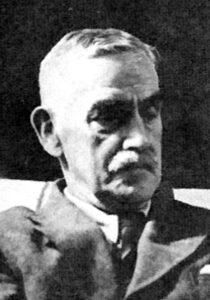Tea and Limuru School
What have Kenya tea and Limuru Girls’ School got in common? The answer is Arnold Butler McDonell, the founder of both the Kenyan tea industry and Limuru School. Three McDonell brothers, Ronald, George and Arnold, and their sister Gertrude (later Magee), came to East Africa in 1905 and 1906. Arnold (born on 17 October 1872 at Forest Gate, London) found work at a logging station, but in 1910 bought 350 acres at Limuru, where he built a house and started a farm, which he called Kiambethu. Because of the altitude (7,200 feet) he failed with corn, flax and coffee. Then the First World War intervened and he joined the East African Mounted Rifles.
At the end of the war a friend sent him some tea seeds (Camellia sinensis assamica) from India. He planted a few acres and found that the bushes flourished – conditions were just right. From these small beginnings the Kenya tea industry developed into a billion dollar enterprise. At first the tea was all processed on the farm and sold to Nairobi traders, but tea soon caught on and was planted elsewhere on high land in Kenya. Brooke Bond built a tea factory at Limuru in 1926.
McDonell married in 1908. His future bride, Agnes Evelyn Harriott Lillingston (born on 2 February 1877), the youngest of a vicar’s eleven children, arrived in Mombasa and was whisked straight to the church to be married in case she changed her mind. The marriage produced four daughters – Evelyn, twins Mary and Edith, and Violet (‘Judy’). How were these girls to be educated? McDonell decided to start a small school for them at the farm, with his governess as the first headmistress. Girls from neighbouring farms were welcome to attend and the school opened in 1922. In 1926 McDonell sold the school and 60 acres of the farm to the Church Commissioners’ Society, which wished to have a diocesan school in Kenya. Ten years later the Commonwealth and Continental Church Society became responsible for the school, which was later taken over by the Kenya government. Today it is a national public secondary school.

Arnold Butler McDonell
In the early days of the school McDonell would ride a bicycle down to Nairobi to play football, and then cycle back again, buying whisky on the way to assist him with the uphill slog. He created a disciplined and structured environment at the school – ‘we wore brown tunics over cream blouses, and white ankle socks inside strong brown shoes. On Sundays we wore limp, turquoise Sunday dresses. We filed into the dining room in orderly fashion to stand behind our chairs until grace had been said.’ According to another early pupil: ‘I was sent off to boarding school, but it was a boarding school with a difference. The school itself consisted of one large room built by A.B. McDonell who had embellished it with a splendid wood carving of St George and the Dragon over the fireplace. We were a total of 12 pupils, aged about 10 to 12, which included the daughters of the McDonells. Some of us boarded with that family whilst the rest lived with a family called Magee a little further up the road.’
A later pupil, Pamela Scott, wrote: ‘We were aged from about 6 to 12 years. There were two wooden buildings, one the dormitory and the other the classrooms and dining room. We only had two classes, the ‘big ones’ and the ‘little ones’. We had lessons in two rooms and at the other end was the dining room. We had outside long-drops…although we did have running water for baths. We led a fairly frugal life; except on Sundays we were not allowed to put butter and jam on our bread, only one or the other. We had maize meal porridge for breakfast, usually burnt and lumpy, with unrefined sugar and milk gone sour, which we hated; for supper we had sweet potato or maize meal cob. For lunch we had meat and vegetables. We went for walks or ran all over the place at Limuru; they did try to teach us netball and other games but there were not enough children to make proper teams…We used to collect safari ants and put them in the piano when the music mistress was trying to play; they would come out and bite her just when she was in the middle of her best piece. One way and another we were distinctly wild…On Saturdays we were allowed to get out of our gym tunics, shoes and socks…and get into a khaki shorts with bare feet which we liked best. We used to have picnics by the little streams near the school and one of our favourite pastimes was to go up to the Tigoni police station and watch the askaris practising their bayoneting.’
The school wood carvings were the result of McDonell’s skill at the art. The gargoyles at the ends of the beams in Brackenhurst dining hall were his, and he did most of the carvings in Limuru church, in the reredos behind the altar, the front of the altar, the ends of the choirstalls, the pulpit, the kneeling stools for the vicar and the panels in front of the gallery. McDonell also designed the church, built in 1939. He and his wife are fittingly buried in its churchyard: Agnes died on 17 March 1963 and McDonell followed on 11 June 1970.
A database of people of European origin in Kenya before 1939, prepared by Peter Ayre and Christine Nicholls, will soon appear on the internet at www.csnicholls.co.uk
www.csnicholls.co.uk

Recent Comments